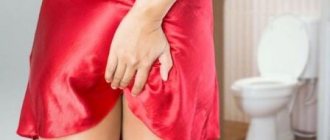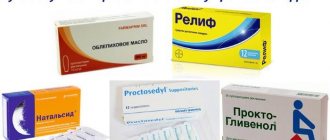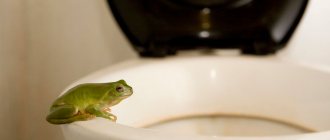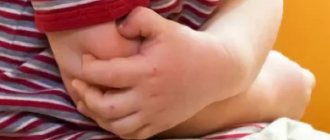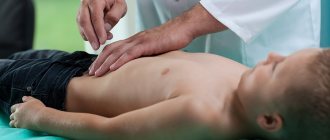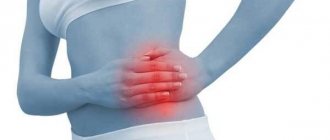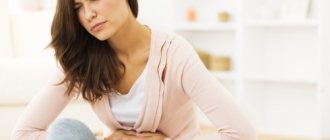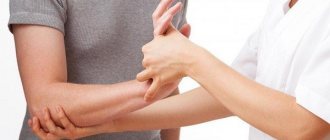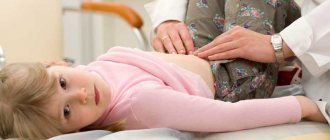Why does pain appear in the lower abdomen?
Usually, some pain in the abdominal cavity with hemorrhoids does not frighten a person. But the blood literally flooding the toilet causes him real panic. But if you visit the doctor for minor reasons, you can control the disease and avoid serious complications.
Most often, pain accompanies constipation. This is a pathology of the digestive structures, which is often considered a provocateur of hemorrhoids.
When constipated, it is difficult for a person to defecate: he sits on the toilet for a long time (and this only aggravates the situation), greatly strains the muscles of the anus, but there is virtually no result.
Irradiation of pain is the mechanism that leads to pain in a seemingly unusual place. Inflammation occurs where there is a whole cluster of nerve endings, and this only intensifies the pain. The patient's suffering increases.
And, most importantly, one of these zones is the perianal zone. This is the area that rings the anus. There really are a lot of nerve endings, they are all very intertwined, so the pain is felt in other areas.
Main causes of pain
Pain occurs during bowel movements due to tension in the sphincter and anus.
There are also complications of hemorrhoids, which include:
- Infectious nature of the lesion;
- Pinching of the hemorrhoidal node (occurs when the muscles above the venous node close as a result of spasm, resulting in back pain when sneezing or moving);
- Blood clot formation (cone thrombosis causes irritation in the perineum);
- Cracks in the anus.
Intense pain occurs due to irritation of the walls of the rectum, the tissues swell and become dense, and the nerve endings and veins of the rectum are gradually compressed.
The appearance and development of hemorrhoids is promoted by constipation (poor diet, consumption of small amounts of clean water), heavy physical activity, undergoing operations on the anal mucosa, and constant long-term sitting on a hard surface.
Why does the lower abdomen hurt with hemorrhoids?
If the lower abdomen and lower back hurt with hemorrhoids, this indicates the appearance of internal nodes. As stool moves through the intestines, its walls contract, so the intensity of the discomfort does not depend on bowel movements. The pain is constant and aching. Patients complain of:
- discomfort in the lower abdomen;
- discomfort in the left side;
- pain in the perineum and lower back.
The reasons for this condition are:
- The presence of inflammatory processes that cause constipation. Against this background, bowel movements are not carried out on time and the stool hardens. As they pass through the intestines, they stretch the walls, thereby causing pain.
- When feces injure the mucous membrane and perineum, cracks form. This can lead to the development of proctitis and fistula. In this case, pain is felt in the lower back and lower abdomen.
- During diarrhea, intestinal motility is impaired. The patient complains of abdominal discomfort.
- Disruption of the gastrointestinal tract and metabolic processes leads to increased gas formation and bloating. The intestinal walls stretch, and the patient begins to experience colic.
Symptoms to watch out for:
- Irradiation of pain occurs beyond the diseased organ with the help of nerve endings. For example, there is discomfort in the groin. Further, unpleasant sensations are easily transmitted along the nerves to nearby abdominal organs. That's why people even complain about back pain when they have hemorrhoids.
- With stagnation of feces, a disturbance in the intestinal microflora is observed. Infection and other pathogenic microorganisms, penetrating inside, cause inflammatory processes. A person feels pain in the umbilical region.
- The patient's psycho-emotional state suffers greatly. Due to excruciating pain during defecation, he puts off going to the toilet, thereby aggravating the situation. Stool hardens even more due to prolonged constipation. The patient suffers from headache, dizziness, insomnia and nausea. It has a placebo effect. As soon as he remembers the unbearable pain, he immediately feels whether the lower abdomen hurts with hemorrhoids.
If you have internal hemorrhoids, you should not delay treatment. It is necessary to restore venous outflow as quickly as possible, this will solve the main cause of varicose veins. Therapy will also be aimed at preventing the appearance of new lumps and nodes.
In men
In the stronger sex, hemorrhoids may cause pain in the lower abdomen. But for a reliable diagnosis, you should consult a urologist to rule out inflammatory processes in the genital organs.
Hemorrhoids in the later stages of their course can be clearly seen visually and the nodes can be felt during a rectal examination. This serves as confirmation of the presence of this disease.
Among women
When a woman feels pain in the lower abdomen, she needs additional examination. It is necessary to exclude gynecological pathologies and problems of the genitourinary system.
Pain in the lower abdomen with hemorrhoids in women can intensify:
- during pregnancy;
- during critical days;
- after childbirth;
- after anal sex.
It is more difficult for women to detect internal hemorrhoids on their own, so it is better to consult a doctor at the first symptoms for timely detection of the disease.
In the later stages of the disease, when hemorrhoids begin to fall out, it is necessary to make an appointment with a gynecologist to prevent the development of gynecological diseases.
Treatment
Problems with bowel movements need to be eliminated in a comprehensive manner, including dietary nutrition, a special drinking regime, traditional medicine recipes and medications. Only a doctor can select a set of measures against constipation, taking into account the health status of a particular patient.
Nutrition
In most cases, unhealthy foods and improper cooking methods are the main cause of constipation and back pain. That is why experts recommend first trying to adjust your daily diet and only taking laxatives as a last resort.
The diet for constipation is based on the following principles:
- The daily amount of food should be divided into six meals. The interval between doses should not exceed two hours. This will allow the intestinal system to constantly work and remove stagnant fecal tumors from the body.
- In order to ease the work of the stomach, it is recommended to chew food for a long time and thoroughly.
- For constipation, your daily menu should include foods with coarse fibers, which speed up the digestive process and restore normal stool. This includes vegetables, fruits, herbs, oatmeal and buckwheat, lean meats and fish, fermented milk products with live bacteria.
- We exclude from the daily menu products with a binding effect, namely bakery and confectionery products, rice, semolina, animal fats, preservatives, spices and smoked meats.
- We cook in a healthy way with a minimum amount of vegetable fats, for example, steamed or in the oven.
Drugs
As a last resort, if the diet menu does not help, you can restore normal stools with the help of a laxative. Only a doctor can select a safe drug, taking into account the age and health status of a particular patient.
So, we can highlight the following popular laxative drugs:
- Based on senna herb extract, which has a laxative effect. These are Senalex, Regulax, Gerbion. The drugs stimulate the work of the muscular system of the stomach, which, in turn, quickly removes toxins from the body. However, senna herb is contraindicated for pregnant women and children.
- Based on lactulose, which is safe for children and adults. Lactulose is not absorbed in the body and quickly removes solid waste naturally. Duphalac is especially popular.
Surgical intervention
There are times when it is impossible to restore stable stools with laxatives and dietary nutrition. Such cases include obstruction of the digestive system, when mechanical obstacles appear in the intestines that do not allow feces to move to the natural exit. The problem can only be solved by surgery.
Severe back pain due to constipation, deterioration of appetite and general well-being, and increased body temperature require immediate hospitalization.
Irregular pain and hemorrhoids how to explain them
The standard clinical picture of hemorrhoids does not involve the patient reporting any unusual places of pain. But this is also possible! Of course, the doctor will definitely get to the bottom of the truth: other causes of pain must be excluded. Although the doctor knows why the lower back still hurts with hemorrhoids or, for example, the tailbone aches.
In addition to the perianal zone of pain, it is common to experience:
- In the groin. This applies to a greater extent to men. Their genitourinary system is more susceptible to such pathology. Hemorrhoidal pain can also radiate to organs that are located near the anus. It is possible that with anal fissures and wounds caused by hemorrhoids, a bacterial infection is associated with this disease. The purulent process in the rectal canal often spreads to the prostate and urethra.
- Lower belly. This is due, in principle, to digestive problems. Severe gas formation, as well as dysbacteriosis, lead to stool disturbances and constipation. That is, it is quite possible that negative sensations in the peritoneum are associated with disordered intestinal activity.
- In the sacrum. They sometimes appear due to pinching of the inflamed lump by the sphincter. The pain is severe, with shooting pains with a certain impact in the lumbar region. Patients may complain to the doctor about undesirable sensations in the sacral area during intestinal emptying. Indeed, the mechanical pressure of rocky feces during prolonged constipation can affect the nerve roots of the spine, which is why it hurts.
- In the tailbone. As a rule, this pain appears during bowel movements. Fecal accumulations go through the rectum, putting pressure on its walls and on the sphincter. The nerve endings are all nearby, so it seems that the tailbone also hurts. But if the pain does not go away for a long time, there is a possibility of complications developing - for example, a fistula or paroproctitis. But the tailbone can still hurt due to bone disease: eliminate such a threat.
Doctors will tell you whether hemorrhoids can cause back pain. Most likely, it hurts not because of the vascular pathology of the rectal canal, but because of the static position that the patient must take during an exacerbation.
How to get rid of discomfort
For external hemorrhoids, it is recommended to use ointments.
To combat the problem in the early stages of development, they resort to drug therapy. Candles are an effective remedy. For external hemorrhoids, it is recommended to use ointments. They soothe the tissue around the anus, relieve irritation, itching and inflammation.
To treat the disease and improve a person’s condition, it is necessary to reconsider the lifestyle.
Special gymnastics classes will help improve your physical fitness. This also has a positive effect on the condition of the back: lower back pain decreases.
In later stages, the disease occurs with complications. In this case, surgical intervention is often resorted to. After removal of hemorrhoids, unpleasant signs of the disease disappear not only in the perianal area, but also in the lower back and sacrum.
To treat back pain, it is recommended to use pain-relieving ointments. The drug for treatment should be prescribed by a general practitioner after consultation and examination.
Medical certificate: hemorrhoids and its stages
Diet for hemorrhoids
Massage has a good effect. It improves blood circulation, relieves stress, and eliminates congestion in blood vessels.
It is important to remember that pain in the spine is not always a symptom of hemorrhoids. Problems often appear in connection with other pathologies. It is necessary to conduct an examination of the whole body.
If the doctor determines that there is no other cause of back pain, then symptomatic treatment will help. Any exacerbation must be prevented - do not do anything that provokes it. Remember that even one feast with a couple of glasses of wine can cause another exacerbation. Therefore, you need to carefully monitor your diet, lifestyle, and physical activity.
Treatment of hemorrhoids with pain radiating to the lower back should be carried out with the inclusion of drugs with an analgesic effect in the therapeutic regimen.
The most effective candles in this regard are:
- Relief (different types);
- Anestezol;
- Ultraproct;
- Anuzol;
- Proctosan or Procto-Glyvenol.
Local therapy involves not only the use of suppositories, but also the use of ointments. So, Troxevasin, Fleming's ointment, Relief, Bezornil, Levomekol, as well as Posterizan and others will be useful.
Before you begin to get rid of pain in the lumbar region due to hemorrhoids, it is important to make sure that the cause of back pain is venous inflammation in the rectum. This disease is dealt with by a coloproctologist, or you can contact your local physician.
After the diagnosis has been established, topical agents and suppositories are prescribed to eliminate the consequences of dilated anal veins.
Let's look at the most common drugs.
"Relief"
These suppositories are used to treat hemorrhoids at any stage with constipation, anal fissures, after surgery, and eczema.
Contraindications for use: allergies to the components of the drug, lactation period, diseases of the urinary system, thyroid gland and liver, tuberculosis, diabetes, viral infections of the body.
Heparin ointment
The product helps resolve blood clots, prevents the formation of tumors, and relieves congestion.
Contraindications include: problems with blood clotting, menstruation in women, hypertension, ulcerative lesions of the gastrointestinal tract, cirrhosis of the liver.
"Finalgon"
The ointment has an analgesic effect, dilates blood vessels, accelerates metabolism, which as a result makes the muscles more elastic and resistant to stress.
The ointment is effective for inflammation in the joints and muscles, for pain in the sciatic nerve, for bruises and sprains, for diseases of a neuralgic nature.
Contraindications: personal intolerance to the components, age restrictions (can be used in patients over 12 years of age), the presence of open wounds on the skin, cannot be applied to the face and neck, increased skin sensitivity.
"Troxevasin"
Stops bleeding, improves the condition of capillaries, has an anti-inflammatory effect and prevents thrombosis.
Contraindications: inflammation of the veins with the presence of blood clots, chronic venous insufficiency, varicose dermatitis, inflammation of the tissues around the venous vessels.
Non-steroidal anti-inflammatory drugs in tablets: Ibuprofen, Nise, Pentalgin will also help eliminate pain in different parts of the back.
Diet is the most important blow to hemorrhoids
Diet is the first word that should be on the list of attitudes of a person diagnosed with hemorrhoids who plans to recover. A diet does not mean that from now on your menu will be meager, monotonous, and tasteless.
You can’t eat your whole life according to the principle “what I want, when I want” and still remain a healthy person. In a sense, you are challenging the body, and you won’t have to wait long for an answer.
But if you decide to come to your senses and actually help your body with proper nutrition, the result will also not be long in coming. Only the result is different – positive.
Why does the lower abdomen hurt with hemorrhoids - also because you eat not in defiance of the disease and for the purpose of recovery, but to please it, the disease.
What causes hemorrhoids to progress:
- Spicy, very fatty, marinated and fried foods;
- Alcohol;
- Strong tea and coffee;
- Chocolate;
- Rice (any);
- Milk;
- Semolina;
- Pasta;
- Potato;
- Baking and confectionery products.
With your diagnosis, such food can safely be called harmful. Moreover, it has low levels of fiber - the most important element for healthy digestion. You should include vegetables, fresh fruits and herbs in your healing table.
Pain in the back, sacrum
Back pain with hemorrhoids is confirmation of an exacerbation in the first and second stages. The period is not characterized by external manifestations, so the symptom should be taken more carefully. They can prompt you to undergo a medical examination to identify the problem and prescribe effective treatment. To minimize them before going to the doctor, it is recommended to change positions more often and not remain motionless for a long time.
Often the advanced form causes pain in the sacrum. This is due to the fact that the pain caused by inflammation of the nodes or irritation of the anal fissures can be so severe that its localization expands from the anal canal area throughout the lower back. The tailbone may hurt due to fistulas, paraproctitis - dangerous complications that need to be dealt with immediately under the supervision of a proctologist.
Pain in the sacrum can occur with advanced hemorrhoids
But often sacral pain is:
- consequences of injury;
- manifestation of pinched nerves
- symptom of back disease;
- factor of dysfunction of the spinal column.
It is enough to contact a traumatologist or neurologist to receive a massage appointment for the sacral area. This should be enough for recovery and relief from unpleasant sensations, and a visit to the proctologist is not necessary.
httpv://www.youtube.com/watch?v=embed/bTulnkihIhM
Treatment of back pain from hemorrhoids
Before starting treatment for a sore back, you need to make sure that the culprit of the pain is hemorrhoids and not another pathology. To clarify the diagnosis, visit a coloproctologist and other medical specialists. When the status of hemorrhoidal disease is confirmed, and no other causes of back pain are found, along with the treatment prescribed by the doctor, you can use additional recommendations.
Ointments for treating back hemorrhoids
Treatment of back pain begins with eliminating the effects of varicose anal veins. External ointment preparations are a convenient remedy for treatment at home.
It is recommended to use ointments to relieve back pain:
- Bystrum-gel is a domestic analogue of Fastum-gel based on ketoprofen. Refers to non-steroidal anti-inflammatory drugs for pain control. Apply a thin layer to the back twice a day, rub in with massage movements. The gel is contraindicated for pregnant women, nursing mothers and children under 15 years of age. Ketonal, Pentalgin Extra-gel, Spazgel, Valusal ointments/gels have a similar composition with anti-inflammatory and analgesic effects;
- Dolobene gel is a multi-component medicine for the back. Heparin sodium prevents thrombosis, dexpanthenol will eliminate swelling and redness of the skin of the back. Dimethyl sulfoxide will eliminate inflammation and relieve swelling in the sore area of the back. It is imperative to clean the skin of your back before applying the gel. Apply the product 2 to 4 times a day;
- Finalgon - contains a synthetic analogue of capsaicin, the hot ingredient in red pepper. External products Analgos cream and Capsicum ointment have a similar composition and effect. Ointments with capsaicin will relieve inflammation, numb the subcutaneous layer and back muscles. You can take warming ointments up to 3 times a day. Before first use, it is recommended to apply capsaicin ointment to a limited area of the back and monitor the skin reaction.
Abdominal pain is a symptom of hemorrhoids
If the soreness is localized in the rectum, this may indeed not be the most typical symptom of hemorrhoids. When the pathology is just forming, the patient feels a slight tingling in the anus, and severe discomfort appears during defecation.
Hemorrhoidal pain can be:
- Pulling;
- Aching;
- Cramping;
- Sharp;
- Incessant.
Cramping pain occurs when the intestine narrows, as the seals become inflamed. Continuous, aching pain appears due to the lower part of the peritoneum being touched. Sometimes this is indeed a very alarming symptom, indicating that necrosis and even peritonitis have joined the disease.
Causes of pain irradiation
The irradiation of pain from hemorrhoids is determined by the individual sensitivity of the patient. Half of the patients have no such symptom as pain at all. The creation of a focus with increased excitability in the regional areas of the spinal cord responsible for the rectum and pelvic organs depends not only on the severity of the inflammation.
Neurologists and psychiatrists are aware of similar symptoms provoked by stress. Vague sensations are called proctalgia. Treatment is not complete without sedatives. The diagnosis is made only after examination with the participation of specialists in various fields.
Preventive measures
It is recommended to follow preventive measures not only for sick people, but also for healthy people. Even after hemorrhoid surgery, preventive measures must be taken. This significantly increases the effectiveness of drug therapy and prevents the risks of exacerbation.
The basic principles of prevention include:
- maintaining a healthy lifestyle;
- balanced diet;
- moderate physical activity;
- special exercises.
If you change your lifestyle and gradually accustom yourself to the established rules, then over time it will become a habit.
Lifestyle
When a person leads a sedentary lifestyle, the resulting stagnation of blood leads to the formation of hemorrhoidal cones and nodes. If your job is sedentary, it is recommended to get up every hour and walk for 4–5 minutes, and take daily walks.
Nutrition
By enriching your diet with a variety of fruits, vegetables and dairy products, your stool will gradually be restored and your well-being will improve significantly. Drinking mineral water helps strengthen intestinal motor function.
Physical exercise
Excessive physical activity should be avoided. Sports activities are welcome, but they should be moderate, just to keep the body in good shape.
Exercises
A set of exercises is based on restoring blood circulation in the perineum. They are very easy to use and can be carried out even at the workplace.
Lifestyle with hemorrhoids: what will resist pain
Symptomatic treatment still cannot be called a complete prevention of the disease and its exacerbations. Very often, the patient already has some kind of back problems, and they are aggravated by those moments that determine his daily life. What he eats, how he sits, whether he plays sports, what shoes he wears, finally. If you move little, then the development of hemorrhoids is very likely, as is the simultaneous development of pathologies of the spinal column.
How to protect yourself from these ailments:
- Your diet should be balanced. The saying “we are what we eat” is very wise. The daily menu should include cereals, vegetables, fruits and dried fruits, nuts, lean meats and fish. Drink plenty of clean water - about 8 glasses a day.
- Give up what clearly clogs your body - fast food, processed foods, smoked and salty foods, carbonated drinks, sausages. Alcohol should be a rare pleasure, and if you drink, it’s just a little, literally, a glass of dry wine. Healthy people can drink good alcohol more often; the same half a glass of wine with Friday dinner is quite acceptable. But if you have hemorrhoids, this practice may increase flare-ups.
- You definitely need moderate physical activity - the simplest thing you can afford is walking. The same swimming, recreational gymnastics, training on exercise machines - if you have the desire, you will find the time. This is not only the prevention of hemorrhoids, but also the prevention of lumbar pain.
- Pay attention to the hygiene of the anus - remember that toilet paper is unacceptable for hemorrhoidal problems (and, in principle, this is an aggressive hygiene product). Only wet wipes will protect the tissues of the anal area from possible injury. But doctors consider the most correct way to perform hygienic procedures to be washing with cool water (maybe with baby soap) after each bowel movement.
- Wear only comfortable underwear made from natural fabrics, change it daily.
- Try to live in a clear, rather than floating, sleep and rest schedule. Avoid stress, learn to manage your emotions. If you have problems in the emotional sphere, be sure to contact a psychologist: do not accumulate problems and dissatisfaction with yourself inside.
- Finally, the most important recommendation is to trust the main things, problems and decisions in your life to professionals. Don’t diagnose yourself “on the Internet.” Information material is information from which you can build on and understand some new knowledge. But a doctor must treat you: with an individual treatment regimen, high-quality diagnostics and a personal prognosis for the success of therapeutic actions.
Where might the pain be, and is it related to hemorrhoids?
With hemorrhoids, pain occurs in the sacrum. They appear during the act of defecation, since the “waste” of the body, when moving through the rectum, affects its walls and injures damaged blood vessels, and the sensations from this are transmitted to adjacent areas.
Painful sensations in the lower abdomen due to hemorrhoids appear due to irradiation or due to disturbances in the functioning of the gastrointestinal tract. As a result of prolonged constipation, bloating occurs, causing nagging pain and tension in the abdominal muscles.
Discomfort in the abdomen, genitals and pain in the sacrum due to hemorrhoids can be alleviated with appropriate treatment. An effective method for treating hemorrhoids is massage. It relieves unpleasant symptoms in such situations:
- your back will stop hurting due to the release of excess tension from your back muscles;
- the sacrum will not be disturbed due to the normalization of blood flow in it;
- the lower abdomen will release due to improved functioning of the gastrointestinal tract.
Massage is contraindicated for patients who have a history of diseases such as:
httpv://www.youtube.com/watch?v=embed/bTulnkihIhM
- thrombosis;
- necrosis.
This is due to the fact that such a procedure increases blood flow to the pelvic area, and this can aggravate the patient’s already painful condition. Therefore, only the attending physician has the right to decide whether massage should be included in therapy for the patient.
The answer to the question: can hemorrhoids cause lower back pain can be answered in the affirmative. But first you need to make sure that this diagnosis is correct, because discomfort in the back with hemorrhoids may not be associated with it. It is not recommended to make hasty and unfounded decisions in this situation. By the way, with hemorrhoids, the lower back hurts only if the patient suffers from its internal form. The external type of the disease does not cause such symptoms. Pain with hemorrhoids of this type occurs only on the affected skin. For the period of time during which the answer to the question will be identified: does the lower back hurt with hemorrhoids, medications that have an analgesic effect will help get rid of the painful sensations.
Our readers recommend
To treat and prevent HEMORRHOIDS, our readers successfully use a natural remedy designed specifically for home use, without injections, surgeries or other painful procedures. This remedy quickly and effectively eliminates bleeding, eliminates itching, prevents pathologies during pregnancy, and most importantly prevents the return of HEMORRHOIDS! Read more…
Constipation pain
Constipation is the most harmful condition for the body, which can lead to very serious diseases. The cause of constipation is a disruption of the gastrointestinal tract itself, which leads to stool retention for several days. It often occurs as a result of poor nutrition.
Constipation should be understood not only as long-term retention of feces in the intestines, but also as systematic weak intestinal activity, which manifests itself in forced, insufficient stool.
Constipation pain is caused by feces that accumulate in the large intestine, causing it to stretch significantly, significantly changing its shape and size. It is because of this that internal organs are compressed and displaced, which negatively affects their functioning. Normal stools should contain 80% water, but with constipation, the amount of water in dry stools does not exceed 60%.
Due to the continued consumption of food in the absence of stool, fecal substances are absorbed into the blood through the mucous membrane of the large intestine and, circulating in it, poison the entire body. The occurrence of pain during constipation is observed in the area of the liver, kidneys and lungs, since they, being secondary organs of excretion, are forced to work under strain.
The accumulation of fecal waste in the connective tissue of the body significantly undermines the immune system. The body in conditions of extremely severe self-poisoning is characterized by rapid aging (wear and tear). And this causes the development of many diseases, ranging from common colds, parasitic diseases and allergies to skin diseases, cardiovascular, oncological, and hormonal disorders.
Advanced constipation is determined by some external signs, namely heavy, often foul breath, a coated tongue, fatigue, poor skin color and hair condition, acne, rashes, excess fat or, conversely, dry skin.
Often, the discomfort caused by pain due to constipation is not directly related to the digestive tract. These include dull headaches with constipation, which are mainly localized in the occipital and parietal regions. There is also a loss of strength, depressed mood and a slight weakening of memory. There is a nervous arrhythmic heartbeat, smell and unpleasant taste in the mouth. Sometimes there are phenomena accompanied by heartburn, belching, nausea and pressure in the epigastric region.
Pain from constipation is often caused by difficult bowel movements, which are often accompanied by tears in the mucous membrane of the anal canal itself. No less common symptoms of constipation are flatulence, a feeling of pressure or expansion, and abdominal pain. Lethargy, fatigue and a general decrease in performance are typical for long-term constipation.
Quite often, constipation is accompanied by headaches, the mechanism of which is still not clear. This kind of pain is usually referred to as effort headaches. Two versions of the occurrence of headaches due to constipation are considered:
- Due to the accumulation of toxic elements in the intestines that penetrate the blood vessels. Circulating with the blood throughout the body, they reach the brain, where their effect on nerve receptors provokes a headache;
- Headaches can be caused by emotional disorders and depression, which often lead to constipation. After all, people with a normal nervous system encounter problems such as constipation much less often.
Symptoms that are typical for constipation headaches are dull, throbbing pain.
To prevent constipation, in addition to observing personal hygiene rules, you should also adhere to a diet that contains sufficient amounts of fiber and fluid. Cleansing enemas can also come to the rescue, which will have a positive result in relieving headaches. Exercise and a healthy lifestyle will also help relieve constipation and relieve stress.
How does the stomach hurt with hemorrhoids, characteristic signs and manifestations
Hemorrhoids during an exacerbation are characterized by inflammatory processes that affect nearby organs. Pain syndrome is felt in different parts of the body and depends directly on where the hemorrhoids are located - inside or outside.
The main signs of hemorrhoids are:
- frequent slippage of hemorrhoids;
- prolonged constipation;
- pain in the rectum.
These symptoms are most worse when:
- venous stagnation;
- digestive dysfunction;
- excessive gas formation;
- flatulence;
- pain during defecation.
If the disease is not treated, it begins to progress and after a few months the above symptoms become increasingly worse.
The intensity of pain depends on:
- location of hemorrhoids;
- neglect of the disease;
- pain tolerance of the patient.
External hemorrhoids form in the outer folds of the anus. They are injured during defecation, after which the person feels excruciating pain in the anus, lower back and perineum. The patient develops fear before every trip to the toilet. It is this type of hemorrhoids that is most common among the population. Therefore, patients often ask the question: can the lower abdomen hurt due to hemorrhoids?
The lower abdomen may ache due to internal hemorrhoids. Pain occurs for several reasons:
- Due to injury to the hemorrhoids by feces during their movement towards the exit.
- Irradiation of painful sensations to neighboring parts of the body.
- Constant contact of the diseased area with the intestinal wall. At the moment of constipation, the wall expands, increasingly injuring the hemorrhoids.
The bumps of internal hemorrhoids are located inside the posterior opening. They are exposed to injury not only during defecation, but also during intestinal peristalsis.
Symptoms of the disease - pain during bowel movements
pain during bowel movements
Defecation (Latin defecatio; synonyms: emptying the rectum, stool, bowel movement - the last word often means feces) is the process of the body excreting feces from the digestive tract (in humans, from the rectum) through the anus.
Normally, a person has bowel movements about once a day (from 1-2 times a day to 1 time in 2 days). Whether bowel movements occur more frequently (frequent bowel movements) or less often (constipation), this is usually accompanied by a change in the physical properties of the stool. Frequent stools usually have a thinner consistency (diarrhea), even watery. When stool is retained, the feces become too rough and hard and can injure the mucous membrane. Cases of intestinal rupture due to hard fecal stones, leading to peritonitis and resulting in death, have been described. As a rule, a violation of the frequency of bowel movements is a symptom of a disease and requires consultation with a doctor (gastroenterologist, proctologist or surgeon). Involuntary bowel movements sometimes occur during childbirth.
Defecation is a complex reflex act involving the cerebral cortex. The stimulus for defecation is the distension of the rectum, but under certain circumstances the urge can be suppressed. Over time, the act of defecation acquires a conditioned reflex character.
Defecation occurs at a certain time and during normal activity of the colon; during the rest of the time there is no urge to defecate, despite the fact that some amount of feces may be in the rectum. Thus, a certain situation, time, a set of impulses, a certain level of filling of the rectum develop a rhythm of defecation that is familiar to each individual.
The participation of the cerebral cortex in the voluntary act of defecation is undoubtedly. The situation, conditions, and opportunities for defecation should be assessed. In addition, in the lumbosacral part of the spinal cord there is a center that coordinates the act of defecation.
Pain and bleeding during bowel movements can be a manifestation of rectal pathologies such as hemorrhoids, anal fissure, tuberculosis, polyps, rectal cancer, parasitic disease (actinomycosis), etc.
What diseases cause pain during defecation:
Causes of pain during bowel movements:
1. Pain during bowel movements, walking and sitting. These are characteristic symptoms of an incipient attack of acute hemorrhoids, i.e. strangulation of the hemorrhoidal node. Since there are a large number of receptors around the anus, pain can be very strong. Bursting pain in the anus intensifies when walking and during bowel movements, and sometimes becomes unbearable, so that the patient is unable to sit or walk.
2. Acute anal fissure is a recently occurring defect in the mucous membrane of the anal canal, when the disease has not yet entered the chronic phase. The course of an acute anal fissure is usually manifested by severe, but relatively short-term pain. Pain is observed only during defecation and lasts on average 15–20 minutes after it. At the same time, an acute anal fissure is manifested by a pronounced spasm of the sphincter, and bleeding is minimal.
3. Submucosal abscess of the rectum is localized in the submucosal layer of the rectum, most often on the posterior wall. Patients complain of dull, sometimes throbbing pain in the lower rectum, a feeling of heaviness in the perineum. The pain intensifies with defecation. The temperature increase is insignificant.
4. Subcutaneous paraproctitis occurs more often than other forms of acute paraproctitis. The abscess is located in the subcutaneous tissue on one side or another of the anus. The disease begins acutely. There is pain in the anus, which intensifies with defecation, hyperthermia, and chills. The disease progresses quickly - the pain becomes pulsating and intensifies with the slightest movement.
5. Sharp pain during defecation is observed with paraproctitis (ischiorectal). The process, capturing the deep layers of tissue in the ischiorectal cavities, quickly spreads behind the rectum to the other side to the prostate gland and, going upward, captures the pelvic tissue. From the very beginning, the disease occurs with severe intoxication, high fever, often with chills, and an increasing deterioration in the general condition. General weakness appears and sleep is disturbed. There is heaviness and throbbing pain in the depths of the pelvic region. Locally, slight swelling of the corresponding buttock is detected, gradually increasing in the following days.
Which doctors should you contact if you experience pain during bowel movements:
Do you experience pain when defecating? Do you want to know more detailed information or do you need an inspection? You can make an appointment with the doctor Euro lab is always at your service! The best doctors will examine you, study external signs and help you identify the disease by symptoms, advise you and provide the necessary assistance. You can also call a doctor at home . Euro lab clinic is open for you around the clock.
How to contact the clinic: Phone number of our clinic in Kiev: (+38 (multi-channel). The clinic secretary will select a convenient day and time for you to visit the doctor. Our coordinates and directions are listed here. Look in more detail about all the clinic’s services on its personal page.
If you have previously performed any tests, be sure to take their results to a consultation with your doctor. If the studies have not been performed, we will do everything necessary in our clinic or with our colleagues in other clinics.
Does your body hurt when defecating? It is necessary to take a very careful approach to your overall health. People do not pay enough attention to the symptoms of diseases and do not realize that these diseases can be life-threatening. There are many diseases that at first do not manifest themselves in our body, but in the end it turns out that, unfortunately, it is too late to treat them. Each disease has its own specific signs, characteristic external manifestations - the so-called symptoms of the disease . Identifying symptoms is the first step in diagnosing diseases in general. to be examined by a doctor several times a year . in order not only to prevent a terrible disease, but also to maintain a healthy spirit in the body and the organism as a whole.
Pain in the rectal area
Pain in the rectum due to hemorrhoids is the most specific of all the listed symptoms. In the early stages of the disease, pain is expressed in tingling and discomfort during bowel movements. During exacerbations, the pain becomes intense and occurs not only during bowel movements, but also in a sitting position.
Increased pain is observed when visiting the toilet due to straining and damage to the nodes
Not everyone knows how hemorrhoids hurt. If the node is inflamed or thrombosis occurs, the pain takes on a jerking, cutting character and occurs with any movement. The pain syndrome can be so severe that the person has difficulty moving
To find out whether hemorrhoids hurt or are a manifestation of another disease, you should pay attention to the accompanying symptoms. When hemorrhoidal sinuses expand, the following may occur:
- mucous discharge from the anus;
- the presence of prolapsed nodes, their swelling and cyanosis (signs of inflammation or thrombosis);
- bleeding from the anus at the end of the act of defecation (blood is released in drops, and sometimes in the form of a trickle);
- anal fissures;
- itching - with hemorrhoids it is caused by secreted mucus and the irritating effect of intestinal contents on damaged mucous membranes.
If there is at least one of the listed signs in combination with pain, we can assume the presence of hemorrhoids. Now let's look at why hemorrhoids can hurt. The causes of pain can be:
- pinching of the prolapsed node by the anal sphincter;
- thrombosis of nodes;
- infectious inflammation of the hemorrhoidal “bump”;
- damage to nodules by feces, especially with constipation;
- anal fissures caused by constipation and frequent use of suppositories.
As mentioned above, patients often delay going to the toilet for fear of a painful attack. As a result, the stool becomes compacted and subsequently damages the hemorrhoidal formations, causing even more severe symptoms. For the same reason, cracks appear that do not heal for a long time and hurt.
Causes of itching
Another manifestation of the disease that is unexpected at first glance is headache. And with hemorrhoids, it quite often bothers patients. This phenomenon may be due to anemia, which develops with hemorrhoidal bleeding. In addition, due to frequent painful attacks and difficulties with bowel movements, patients become irritable and nervous, which also leads to headaches.
However, although pain is particularly unpleasant, it is far from the only sign of hemorrhoids. You can learn about other manifestations of this pathology from the article: Symptoms of external and internal hemorrhoids.
Now you know what kind of pain there is with hemorrhoids and how they arise. More information on this issue can be found here:
httpv://www.youtube.com/watch?v=embed/bTulnkihIhM
Can lower back pain be caused by hemorrhoids?
Oddly enough, this disease sometimes does not involve pain at all. Of course, if you have started the disease, the pain will be serious and will not go away for a long time. But in the early stages of the disease, pain is usually absent.
If the disease progresses, then pain is usually felt in the perineal area. But it happens that back pain is also felt due to hemorrhoids.
Moreover, discomfort is also noticeable in the lower back, in the area of the sacrum, abdomen and genitals. According to some reports, in half of the patients the doctor records atypical signs of hemorrhoids.
The peculiarity of this picture of the disease is that patients attribute lower back pain to the symptoms of osteochondrosis (which, as they say, “everyone has it”), which is why they do not go to doctors on time. And even the neurologist whom they go to with a sore back does not immediately understand the true scenario for the development of pain.
You must clearly determine whether your back hurts due to hemorrhoids, or whether it is another pathology. However, more often pain in the lumbar area occurs for completely different reasons.
Among these reasons:
- Deformation of spinal tissue;
- Bruises, cracks and fractures of the vertebrae;
- Osteochondrosis;
- Inflamed hip joints;
- Intervertebral hernia in the lower back;
- Bone tuberculosis;
- Various types of tumors;
- Epidural abscess;
- Pyelonephritis and other kidney diseases;
- Urolithiasis disease;
- Intestinal obstruction;
- Appendicitis;
- Pain associated with menstruation.
Bruises, cracks and fractures Intestinal obstruction Urolithiasis Epidural abscess Bone tuberculosis Intervertebral hernia Inflamed hip joints Appendicitis
The range of reasons is great - you need to look for the truth in a medical institution. If you yourself are sure that your back may hurt due to hemorrhoids, then be sure to tell your proctologist about this. This information may be useful to clarify the diagnosis: if pain accompanies you during the days of exacerbation, and it is really caused by hemorrhoids, the doctor will tell you what to do about it.
Experts include the following signs as symptoms of hemorrhoids:
- Severe itching in the anal area;
- Due to the lack of treatment, sharp pain appears when moving at the site of the problem;
- After defecation, there may be prolonged aching pain in the anus;
- Burning, swelling;
- In the acute course of hemorrhoids, the intensity of pain in the rectum increases and occurs regardless of changes in body position;
- Bleeding from the anus is possible;
- Formation of anal fissures;
- Prolapse of hemorrhoids outwards.
The localization of pain depends on the degree of development of the disease. As a rule, during the inflammatory process and the formation of hemorrhoids, the patient is bothered by severe pain in the lower abdomen.
In men and women, lower back pain due to hemorrhoids is a common accompanying symptom. With internal localization of the hemorrhoidal process, they can radiate to the lumbar region due to pinching of hemorrhoidal cones.
Back pain can be due to compression and irritation of nearby nerve endings of the spinal column. At the fourth stage of development of the problem, a person is often tormented by painful sensations in the sacrum and coccyx.
In the chronic form of the disease, nagging pain appears in the lower back. Aching, dull painful sensations often occur in the evening. The attack begins with weak impulses, which gradually intensify and reach significant strength. The area below the belt, sacrum and tailbone begin to hurt. Sometimes lower back pain due to hemorrhoids becomes unbearable and spreads up the spine.
You can understand that pain is a sign of hemorrhoids by the time of its occurrence. Patients with hemorrhoids notice that the lower back hurts due to the influence of certain factors on the body:
- after heavy physical exertion, especially heavy lifting, long walking or standing;
- back pain occurs with hemorrhoids from sitting for a long time on a hard, uncomfortable chair;
- During bowel movements, constipation makes it difficult to have a bowel movement. The rectum is damaged by dense feces, pain from the intestines moves to the back;
- after operations on the anal mucosa.
It can be difficult to establish a connection between back problems and enlarged rectal veins. Often people with hemorrhoidal disease are very surprised to learn that hemorrhoids can cause lower back pain.
The most common culprits of back pain due to hemorrhoidal pathology:
- enlarged, inflamed nodes of internal hemorrhoids that protrude outward;
- nodes that have been pinched are very painful. Pinching occurs when the anal sphincter muscles close over the prolapsed vein due to spasm. Back pain when walking, sneezing, sitting;
- thrombosis of the cones of external hemorrhoids at stages 3-4 of development causes pain in the perineum, the spread of pain impulses to the back;
- severe back discomfort is felt during bowel movements. The rectum is injured by dense stool due to constipation;
- excessive tension of the back muscles to empty the intestines with hemorrhoids leads to painful muscle spasm;
- The lower back with hemorrhoids may hurt from nervous anticipation and fear of the painful act of defecation;
- anal fissure is a source of severe pain in the anus, pain spreads to the back near the lower back;
- the first week after removal of hemorrhoids, the rectum hurts, painful impulses rise upward, reaching the sacrum.
Most often, the back hurts with hemorrhoids of the 3rd-4th stage of development, accompanied by prolapsed venous nodes with pinching or thrombosis. The final degree of hemorrhoidal pathology is characterized by inflammation of the anal passage and severe pain. The pain spreads to the coccyx, sacrum and lumbar region. Then the patient cannot straighten his back, and his quality of life decreases noticeably.
This disease is characterized by a chronic inflammatory process in the rectum and anus, which is accompanied by the formation of hemorrhoidal cones (nodes). They are primarily associated with pain and discomfort - as the disease progresses, the lumps can become inflamed, pinched, fall out and even bleed, endangering not only health, but also a person’s life.
Depending on the location of varicose veins and nodes, internal and external hemorrhoids are distinguished. In the first case, pathological changes affect the rectum above its sphincters, so patients can independently see hemorrhoidal cones that have fallen out already in the last stages of the disease.
It is for those who suffer from internal hemorrhoids that the pain most often radiates to the sacrum and lower back, and without timely treatment it becomes so intense that it prevents them not only from doing physical work, but even just walking or sitting. In the second case, the inflammatory process develops mainly in the anus, which is why the person feels the most severe pain and burning in the anus.
In addition to physical pain, this disease is also accompanied by psychological discomfort. Firstly, the problem itself is quite delicate, and patients often hesitate for a long time to tell specialists about it and begin treatment, thereby only allowing the disease to gain momentum and aggravating their condition. And, secondly, the torment that they have to experience during each visit to the toilet creates a fear of this process, which leads to digestive disorders and provokes constipation. As a result, stool hardens and further injures the mucous membrane during bowel movements, causing unbearable pain.
At the beginning of the disease, symptoms appear only periodically and are limited to a slight burning sensation and discomfort in the perineal area, only sometimes affecting the lower back, back, sacrum or lower abdomen. Quite often they are attributed to other diseases that have nothing to do with hemorrhoids, for example, osteochondrosis or gynecological problems in women.
Discomfort and pain in the lower back and sacrum occur in many patients suffering from hemorrhoids. These symptoms more often appear in the internal form of the disease and are associated with a large accumulation of nerve endings in the pelvic area - when a hemorrhoid is pinched or muscle spasms, pain along them can quickly spread to nearby areas, covering the tailbone, sacrum, lower back and even the abdomen.
The pain of hemorrhoids becomes much more intense during an exacerbation of the disease. With a sluggish hemorrhoidal process, they bother a person only when he has been sitting or standing for a long time, as well as when visiting the toilet, and they can be dealt with simply by changing the position of the body and warming up a little. But once the disease intensifies, the attacks become almost continuous and so strong that the person begins to feel his whole body hurting and aching.
In addition, patients with this disease often have to take an unnatural body position - it is difficult for them to sit or lie due to the increased pressure on the inflamed hemorrhoidal cones. Trying to relieve pain, they can remain in an uncomfortable position for a long time, causing muscle strain and lower back pain.
Among women
How to eliminate abdominal pain due to hemorrhoids
When hemorrhoids cause pain in the lower abdomen, to relieve the painful syndrome, the cause that caused this situation should be eliminated. In this case, you should actively begin treating hemorrhoids. Drug therapy involves the use of medications. Treatment can be carried out at home, but with the permission of the attending physician.
The most effective drugs include:
- rectal suppositories: “Relief”, “Anestezol”, “Proctosedyl”;
- Sea buckthorn oil in the form of candles works well for pain;
- inflammation and swelling are effectively relieved by venotonics: Phlebodia 600, Detralex;
Treatment and pain relief using traditional medicine is also encouraged. The main principle in pain relief for hemorrhoids is absolute safety and high efficiency.
- Using raw potatoes relieves pain and inflammation. First you need to peel the raw potatoes and cut them into strips. Take one straw and insert it into the anus.
- An ointment made from carrots and beets effectively relieves pain and relieves inflammation. To do this, you need to take vegetables in equal proportions, finely grind them on a grater and apply them to the anus.
- Carrying out an enema during illness significantly reduces swelling. The result is noticeable after a week of use. A therapeutic enema can be made from wormwood, grated potatoes, and strawberry leaves.
Can be taken internally:
- potato, carrot, beet juice;
- onion juice, which has antiseptic properties.
The use of traditional medicine gives good results, but to achieve them you need to be patient and carry out treatment over long courses.
The mechanism of pain syndrome in hemorrhoids
Hemorrhoids are called “varicose veins of the rectum,” but this is not entirely true. In the mechanism of damage in this pathology, the condition of the musculo-ligamentous apparatus of the rectum is of great importance. Normally, the internal hemorrhoidal cavernous bodies are supported by the Parkes ligament; it fixes the nodular formations under the mucous membrane to the wall of the middle part. External subcutaneous hemorrhoids are indeed venous cavities. However, they are associated with the muscular sphincter. Blood filling is regulated by the reflex process of relaxation and contraction during defecation.
The anatomical position of the rectum in the pelvis next to the bladder, the prostate in men and the uterus in women makes the area very sensitive and exposes it to the danger of rapid spread of inflammation from one organ to another.
The rectal nerves approach from the sympathetic and spinal canals of the spine, having previously formed the superior rectal plexus from the branches of the II, III, IV sympathetic nodes of the lumbar region (runs next to the artery and is woven into the wall of the rectum).
The hypogastric nerve arises from the same source. It, together with many branches of the anterior sections of the II, III, IV sacral nerves, creates the hypogastric plexus.
On both sides on the left and right, in 2–4 thin trunks, the lower rectal nerves approach the external sphincter. They also innervate the mucous membrane of the anus, partly the skin. The perineum and anus receive signals from the terminal branches of several nerves at once.
Stretching of the nodes when overfilled, the subsequent inflammatory reaction serves as a strong overstimulation of the final receptors of the nervous system. The signals go to the corresponding parts of the spinal cord. The peculiarity of the assessment of the received information is the formation of a focus of excitation, which is transmitted to neighboring areas, and from them is sent back along other nerve fibers to the lumbar area, abdomen, and tailbone. This mechanism is called the “axon reflex” in neurophysiology. Thus, the pain syndrome intensifies and radiates from the site of inflammation to other areas where there is virtually no change.
Female physiology ovulation and menstruation
If a representative of the fairer sex has abdominal pain (radiating into the anus), this may be a sign of the release of an egg from the ovary. This process occurs most often in the middle of the menstrual cycle. In this case, unpleasant sensations are most often temporary and end quickly.
Also, abdominal pain radiates to the anus if it is caused by menstruation. In this case, the woman marks the beginning of a new cycle, which is accompanied by the release of blood from the genital tract. Remember that menstruation should not be heavy or prolonged.
Pain in both of these cases can be eliminated by taking antispasmodics. These include the following drugs: “No-shpa”, “Solpadeine”, “Mig” and so on.

